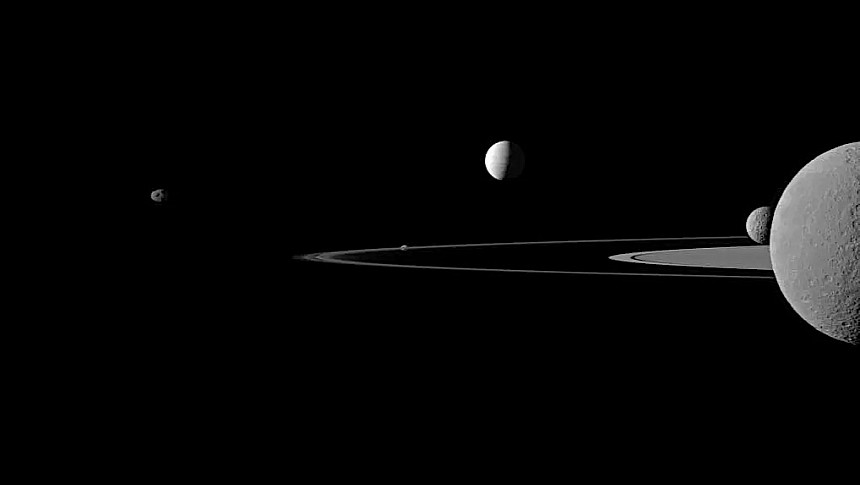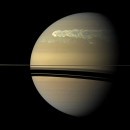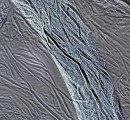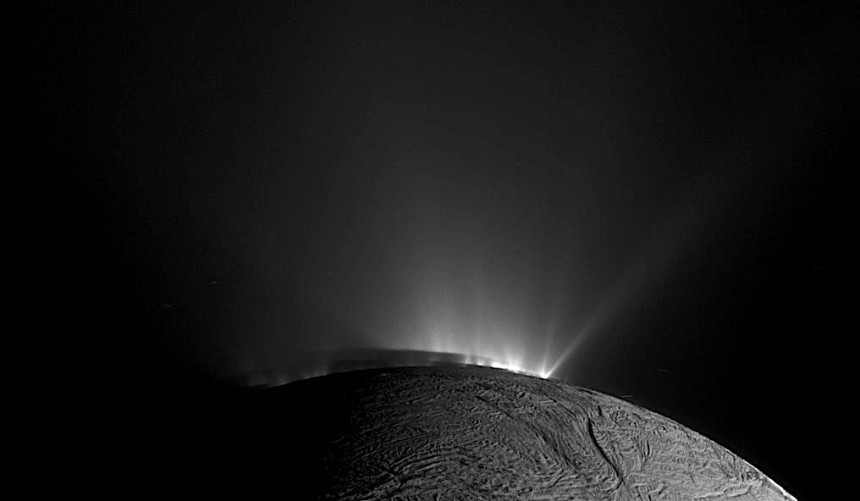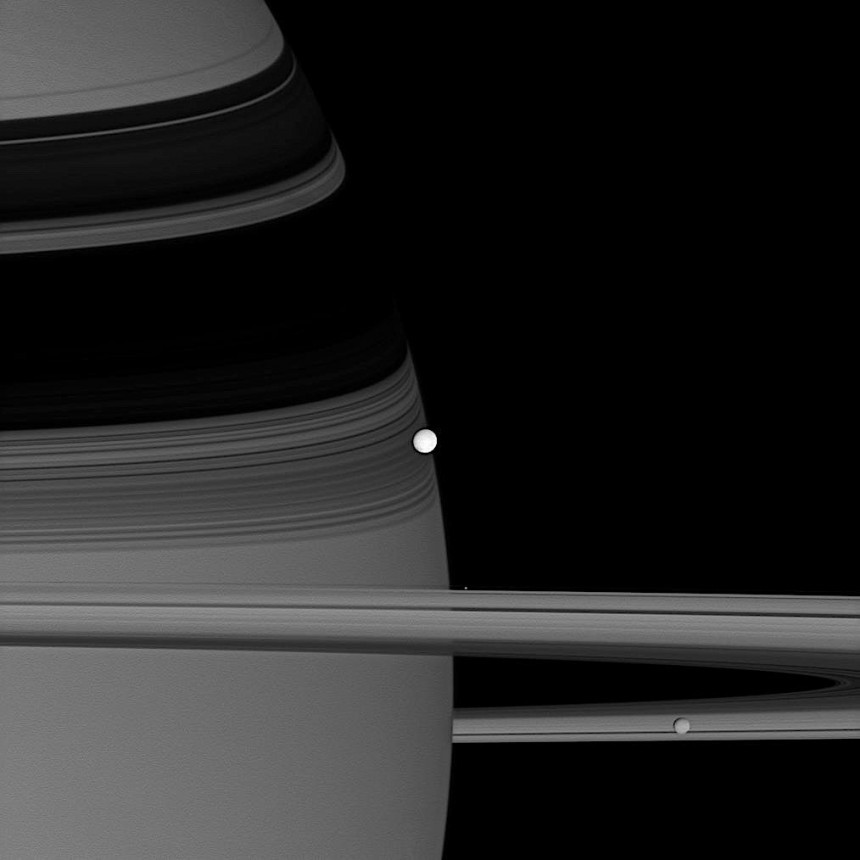At the time of writing NASA listed in its inventory of moons in our solar system a total of 290 such celestial bodies. The bulk of them, no less than 146, circle gas giant Saturn, located at a distance of 793 million miles (1.3 billion km) from our planet.
Of that incredible army of moons, one clearly stands out as a very strong candidate for the title of the second world in Sol capable to support life. That's because it is one of just a few moons of the entire pack we know of to have liquid water. And not just a touch of it, but entire oceans, captured beneath a thick layer of ice.
The moon is called Enceladus, it's about the size of the American state of Arizona and, for all intents and purposes, it has the "whitest, most reflective surface in the solar system." As a result of that, it's an incredibly cold place, with temperatures plunging to minus 330 degrees Fahrenheit (minus 201 degrees Celsius).
The moon orbits its giant companion, with which it is tidally locked (meaning it always has the same side turned to Saturn), at a distance of 148,000 miles (238,000 km), with its orbit sandwiched those of two other moons, Mimas and Tethys.
The place has another peculiar thing about it: it often spits that hidden ocean right into space through geyser-like jets of water vapor and ice particles. That ejecta then forms into the moon's own ring, which is later absorbed into Saturn's E ring.
We don't know precisely why the place does this (our best bet is because of its warmer south pole which helps drive these geysers), but this habit of the moon helped us learn a lot about it.
Back in 1997, humanity launched a spacecraft called Cassini. Its main mission was to study Saturn, its rings, and its moons in the hopes it would give us a better understanding of the place. And it still does, almost seven years after the mission officially ended by being intentionally sent into Saturn's atmosphere.
A new set of data from Cassini fell under the scrutiny of a NASA research team, and the findings are extraordinary to say the least.
You see, we've known for quite some time the plumes of water and ice Enceladus spits into space are filled with organic compounds, including some we know to be important for life as we know it to exist, but until now few truly crucial things were detected.
Have you ever heard about something called hydrogen cyanide? I know, it sounds like poison, and it is, but it's also actually a key ingredient to life, because it's technically a precursor of amino and nucleic acids. And those in turn are building blocks for life.
Combining that with the knowledge that there is also carbon dioxide, methane, and hydrogen in the Enceladus plumes makes the moon a very strong candidate for the existence of life outside our world. And what was needed was the discovery of a source of energy to power said life, given the extreme environment up there.
Well, guess what? The same study that uncovered the presence of hydrogen cyanide points to the presence of "a supercharged source of energy" to fuel life.
The source of energy is chemical in nature, and somehow escaped our scrutiny until now, hidden beneath the ice, in the ocean spread there. Moreover, this source of energy comes from organic compounds, and we know of some of them as being used as a source of energy by organisms here on Earth.
It's unclear at this point how powerful this source is, but the researchers behind the study say it could be a lot more than previously thought. And "the more energy available, the more likely that life might proliferate and be sustained."
What's more important is that this new source of chemical energy appears to be far more powerful than methanogenesis, which is a metabolic process that involves the combination of carbon dioxide, methane, and hydrogen and it's widespread here on Earth.
"Our work provides further evidence that Enceladus is host to some of the most important molecules for both creating the building blocks of life and for sustaining that life through metabolic reactions," said in a statement Jonah Peter, lead author of the study and part of NASA's Jet Propulsion Laboratory in Southern California.
"Not only does Enceladus seem to meet the basic requirements for habitability, but we also have an idea about how complex biomolecules could form there and what sort of chemical pathways might be involved."
On top of all that, some of the compounds discovered in the Enceladus plume have been found to be oxidized, and we know oxidation helps with the release of chemical energy, which in turn supports life.
The fine details of the new study on Enceladus were published in Nature Astronomy last week.
The moon is called Enceladus, it's about the size of the American state of Arizona and, for all intents and purposes, it has the "whitest, most reflective surface in the solar system." As a result of that, it's an incredibly cold place, with temperatures plunging to minus 330 degrees Fahrenheit (minus 201 degrees Celsius).
The moon orbits its giant companion, with which it is tidally locked (meaning it always has the same side turned to Saturn), at a distance of 148,000 miles (238,000 km), with its orbit sandwiched those of two other moons, Mimas and Tethys.
The place has another peculiar thing about it: it often spits that hidden ocean right into space through geyser-like jets of water vapor and ice particles. That ejecta then forms into the moon's own ring, which is later absorbed into Saturn's E ring.
We don't know precisely why the place does this (our best bet is because of its warmer south pole which helps drive these geysers), but this habit of the moon helped us learn a lot about it.
Back in 1997, humanity launched a spacecraft called Cassini. Its main mission was to study Saturn, its rings, and its moons in the hopes it would give us a better understanding of the place. And it still does, almost seven years after the mission officially ended by being intentionally sent into Saturn's atmosphere.
You see, we've known for quite some time the plumes of water and ice Enceladus spits into space are filled with organic compounds, including some we know to be important for life as we know it to exist, but until now few truly crucial things were detected.
Have you ever heard about something called hydrogen cyanide? I know, it sounds like poison, and it is, but it's also actually a key ingredient to life, because it's technically a precursor of amino and nucleic acids. And those in turn are building blocks for life.
Combining that with the knowledge that there is also carbon dioxide, methane, and hydrogen in the Enceladus plumes makes the moon a very strong candidate for the existence of life outside our world. And what was needed was the discovery of a source of energy to power said life, given the extreme environment up there.
Well, guess what? The same study that uncovered the presence of hydrogen cyanide points to the presence of "a supercharged source of energy" to fuel life.
The source of energy is chemical in nature, and somehow escaped our scrutiny until now, hidden beneath the ice, in the ocean spread there. Moreover, this source of energy comes from organic compounds, and we know of some of them as being used as a source of energy by organisms here on Earth.
What's more important is that this new source of chemical energy appears to be far more powerful than methanogenesis, which is a metabolic process that involves the combination of carbon dioxide, methane, and hydrogen and it's widespread here on Earth.
"Our work provides further evidence that Enceladus is host to some of the most important molecules for both creating the building blocks of life and for sustaining that life through metabolic reactions," said in a statement Jonah Peter, lead author of the study and part of NASA's Jet Propulsion Laboratory in Southern California.
"Not only does Enceladus seem to meet the basic requirements for habitability, but we also have an idea about how complex biomolecules could form there and what sort of chemical pathways might be involved."
On top of all that, some of the compounds discovered in the Enceladus plume have been found to be oxidized, and we know oxidation helps with the release of chemical energy, which in turn supports life.
The fine details of the new study on Enceladus were published in Nature Astronomy last week.
